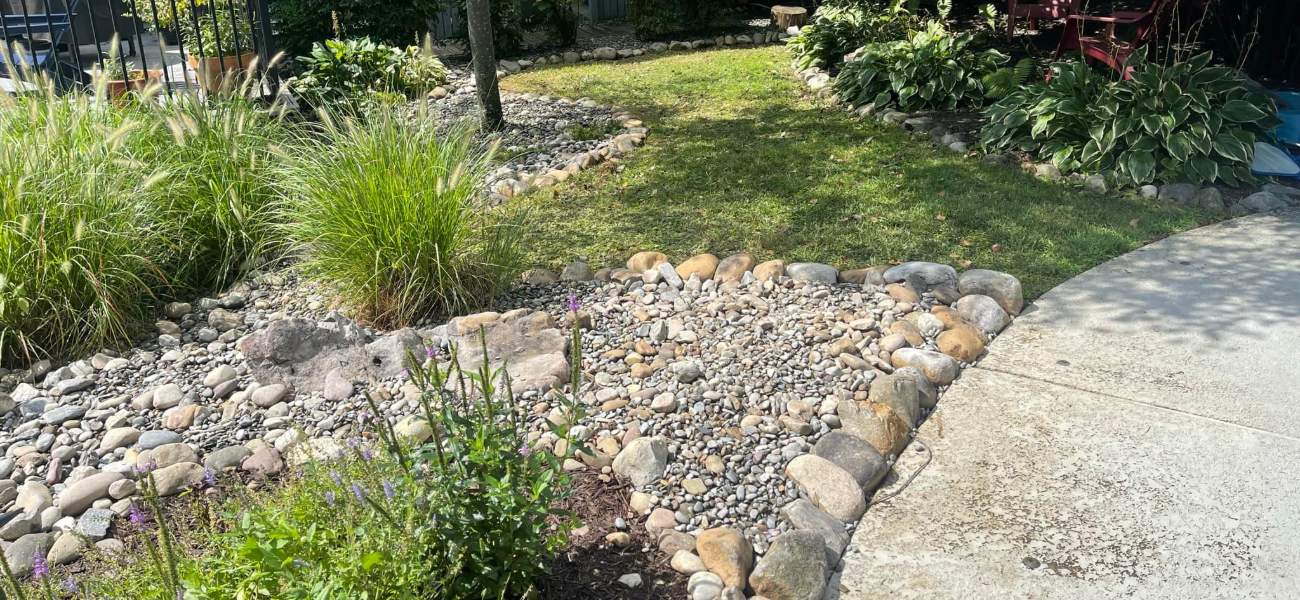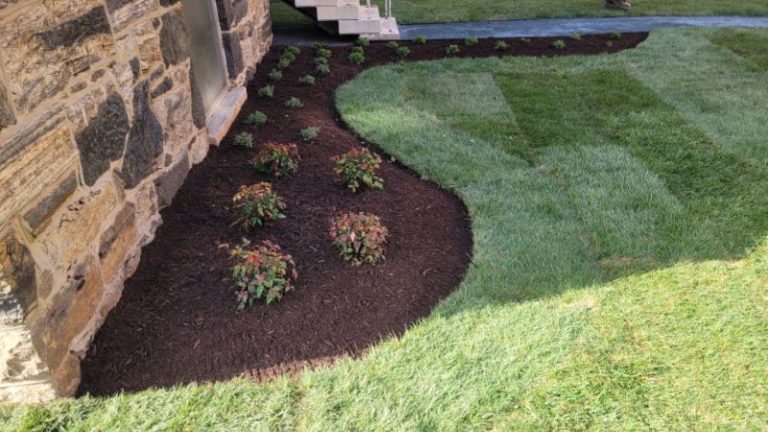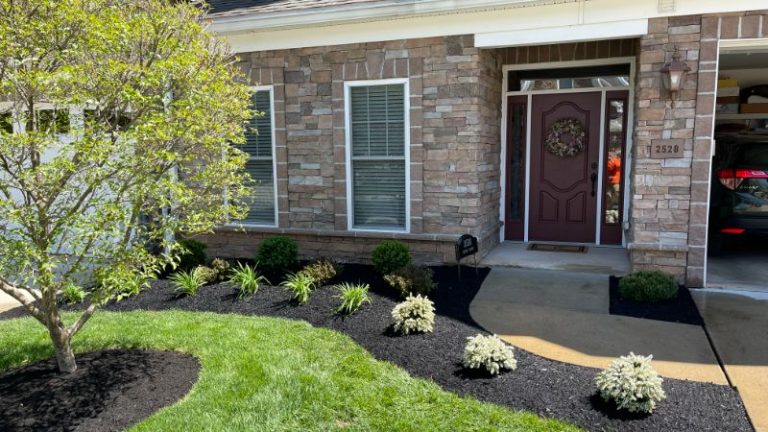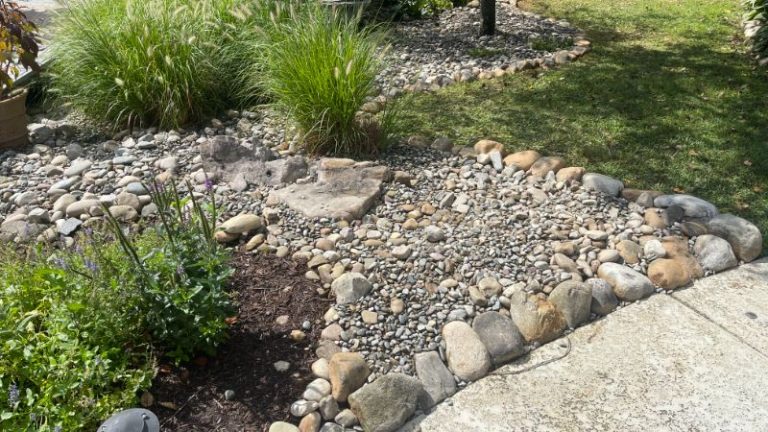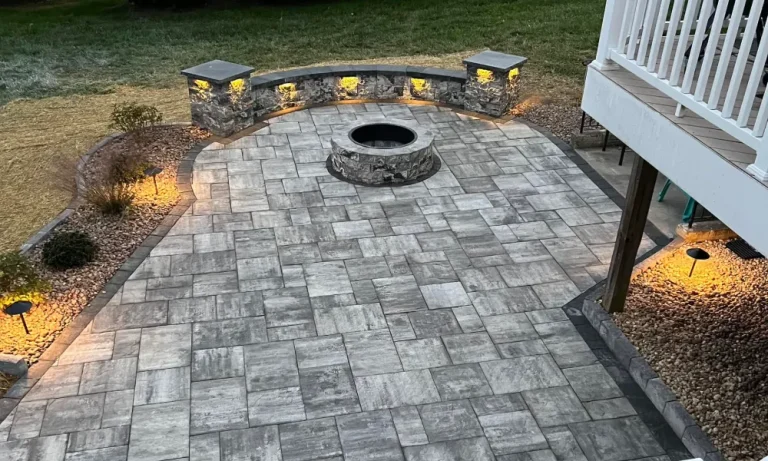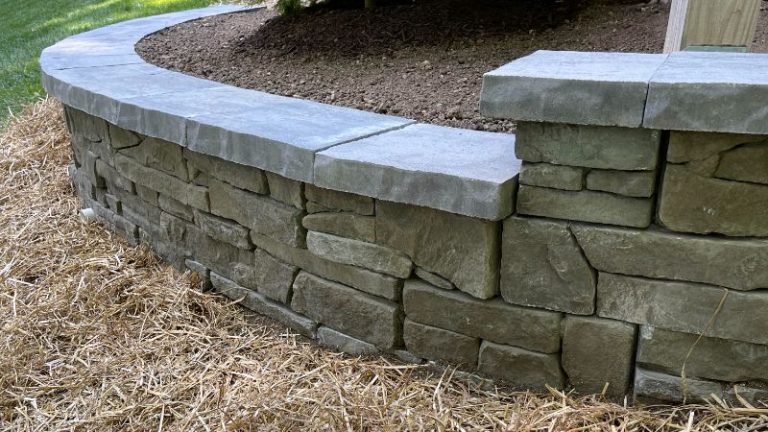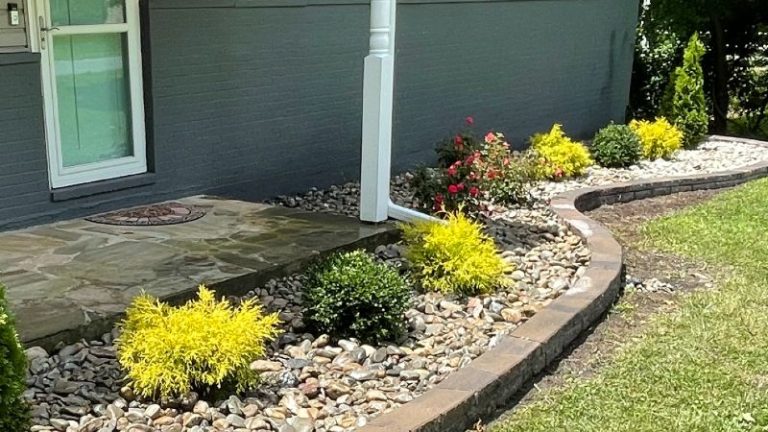Incorporating Dry Creek Beds Into Your Landscape
A Functional and Beautiful Drainage Solution
Dry creek beds are one of the most versatile and visually appealing solutions for homeowners dealing with drainage issues. These features mimic natural streambeds and are designed to redirect stormwater runoff in a way that blends seamlessly into your landscape design. For homeowners in Harford County and surrounding areas, dry creek beds offer a practical and low-maintenance option that enhances both curb appeal and function.
What Is a Dry Creek Bed?
A dry creek bed—also called a dry stream or dry riverbed—is a shallow, meandering trench filled with decorative stone, gravel, and sometimes native or drought-tolerant plants. While it mimics the look of a natural creek when dry, it’s actually a functional drainage solution designed to manage stormwater runoff during and after periods of heavy rainfall.
Unlike traditional underground drainage systems that rely on piping and grates, a dry creek bed works above ground, harnessing the natural slope of your property to redirect water away from your home, patio, garden beds, or low-lying areas. When installed properly, it becomes an integrated part of the landscape that looks beautiful year-round—even when no water is flowing through it.
A Dual-Purpose Landscape Feature
What makes dry creek beds so appealing to homeowners in Maryland is their ability to serve two purposes:
-
- Functional Water Management
During storms, a dry creek bed captures and channels surface water, helping to reduce puddling, flooding, or erosion. This is especially useful in areas with heavy clay soils (common in Harford County), where water tends to collect rather than soak into the ground quickly. - Aesthetic Enhancement
When dry, the feature blends seamlessly into the surrounding landscape, resembling a dry mountain stream or decorative garden bed. It brings texture, movement, and visual interest to the yard—often acting as a natural focal point in both modern and traditional landscape designs.
- Functional Water Management
Key Components of a Dry Creek Bed
A professionally installed dry creek bed includes:
-
- A shallow trench carved to follow the natural flow of water on your property
- River rock, gravel, or crushed stone to line the base and control erosion
- Larger boulders or edging stones to add structure and visual definition
- Optional plantings like ornamental grasses, native perennials, or low shrubs to soften the edges and promote water absorption
- Filter fabric beneath the stone to prevent weed growth and maintain separation between soil and stone
When designed by experts, a dry creek bed becomes more than just a drainage feature—it becomes a naturalized element of your landscape, working in harmony with your planting beds, lawn, and hardscape areas.
Benefits of Adding a Dry Creek Bed to Your Yard
If your property experiences frequent pooling, poor drainage, or erosion issues, a dry creek bed offers a smart and beautiful solution. This type of feature not only helps manage stormwater runoff but also enhances the visual appeal of your landscape. At Harvest Outdoor Living, we design dry creek beds that are both functional and aesthetically integrated into your yard—especially valuable for homes in Harford County and surrounding areas, where heavy rain and compacted soils can cause drainage challenges.
Here’s why a dry creek bed might be the perfect addition to your landscape:
1. Improved Drainage
One of the primary benefits of a dry creek bed is its ability to efficiently redirect water away from problem areas. Whether water tends to pool near your home’s foundation, in planting beds, or in low-lying areas of your yard, a properly graded dry creek bed gives it a clear, controlled path to flow—reducing the chance of flooding or long-term water damage. Unlike underground piping systems, it also encourages natural percolation of water back into the soil, which helps recharge groundwater and reduce runoff.
2. Erosion Control
On sloped or uneven terrain, fast-moving stormwater can cause significant erosion, washing away valuable topsoil, mulch, and plants. A dry creek bed slows down the water’s flow, dispersing it more gently across the landscape. The stones and gravel used in the bed act as buffers, breaking the water’s speed and minimizing the risk of soil displacement. This makes dry creek beds especially effective when paired with retaining walls, grading work, or garden terraces in hilly parts of your property.
3. Natural Appearance
Dry creek beds blend seamlessly into your landscape by mimicking the look of natural streambeds. With their organic shape, textured stone, and optional plantings, they offer a more visually appealing alternative to traditional drainage solutions like PVC pipes or trench grates. When incorporated with native grasses, perennial flowers, or ornamental boulders, a dry creek bed becomes a landscape feature in its own right—not just a practical fix.
4. Low Maintenance
Once installed, dry creek beds require very little upkeep compared to lawn or planting beds. There’s no mowing, trimming, or irrigation required. Occasional maintenance might include removing leaves, twigs, or weeds, but the durable materials—such as river rock, gravel, and filter fabric—are designed to resist erosion and weed growth. This makes it an ideal solution for homeowners seeking low-maintenance landscaping that still looks polished and intentional.
5. Versatility in Landscape Design
A dry creek bed isn’t limited to drainage use—it can be fully integrated into your overall landscape layout. It works beautifully as:
-
-
- A decorative border alongside a paver walkway
- A functional transition zone between lawn and patio
- A soft barrier that separates garden beds from sloped areas
- A natural-looking channel running through a mulched or wooded section of your yard
-
Dry creek beds also pair well with other services we offer, including Cambridge Pavingstones patios, retaining walls, garden beds, and landscape lighting—creating a cohesive and well-thought-out outdoor living space.
Where Should You Use a Dry Creek Bed?
While a dry creek bed is not a necessary feature for every property, it can be a highly effective solution in landscapes with drainage issues, uneven terrain, or a desire for low-maintenance, natural design elements. The key to getting the most from a dry creek bed is knowing where it makes the biggest impact.
Here are some of the most effective and visually appealing places to incorporate a dry creek bed:
1. Along the Side of the House Where Rainwater Flows from the Roof
In many homes—especially those without gutters or with undersized downspouts—rainwater tends to accumulate along the side of the house, leading to erosion, foundation saturation, or soggy turf. A dry creek bed can be installed along the foundation to capture and carry away this water, directing it toward a safe drainage outlet while creating a natural-looking feature. It’s especially useful for homeowners who prefer above-ground solutions over buried pipes.
2. At the Bottom of a Slope to Slow and Redirect Runoff
If your yard has a natural slope, you’ve likely seen water rushing downhill during heavy rain. Without proper management, this runoff can strip away soil, flood planting beds, or pool near patios and walkways. A dry creek bed at the base of a slope acts as a buffer, slowing the flow of water, allowing it to soak into the ground, and safely moving the excess to a more appropriate location.
This approach is often combined with retaining walls, terracing, or regrading—services we offer at Harvest Outdoor Living—to create a full hillside management solution.
3. Through the Middle of a Large Yard to Divide Planting Areas
Dry creek beds don’t have to hide in the background. In larger yards, they can serve as functional focal points, winding through open lawn or planting areas to define zones and guide the eye across the landscape. They’re perfect for breaking up a flat or expansive yard, adding texture and interest where there’s little elevation change or visual variation.
These beds can be integrated with stepping stones, footbridges, or small boulder groupings for a natural park-like feel.
4. Near Downspouts or in Areas with Frequent Puddling
Some properties have chronic puddling problems in certain areas, especially low spots near the home, driveway, or patio. If water collects in the same place after every rainfall, it likely needs a better outlet. A dry creek bed can be used to collect that runoff at the surface and direct it toward a more permeable area or drainage feature.
We often pair this with grading adjustments, rain gardens, or even buried drainage extensions for a complete water management system.
5. As a Decorative Drainage Feature in Rain Gardens or Xeriscaping
Dry creek beds are an ideal complement to rain gardens and xeriscape designs, where the goal is to manage water responsibly while minimizing irrigation and maintenance. These beds can be used to:
-
-
- Carry water into a rain garden where native plants absorb it naturally
- Replace traditional turf or ground cover in dry areas
- Add visual depth to mulch beds, rock gardens, or dry landscape zones
- Blend seamlessly with drought-tolerant shrubs, ornamental grasses, or native wildflowers
-
This approach not only solves drainage issues but also supports sustainable, low-maintenance landscape design.
Design Tips for Effective Dry Creek Beds
Creating a dry creek bed that actually solves drainage problems—while also enhancing your landscape—requires more than digging a shallow trench and filling it with rock. The most effective designs are customized to your property’s slope, soil type, rainfall patterns, and surrounding features. At Harvest Outdoor Living, we approach every dry creek bed project with a balance of form and function, combining drainage expertise with creative landscaping techniques suited to Maryland’s unique climate and terrain.
Here are the key considerations we focus on when designing a dry creek bed that’s both beautiful and built to perform:
1. Proper Grading and Depth to Ensure Natural Water Flow
The most important part of any dry creek bed is its ability to move water effectively. To do that, the trench must be:
-
-
- Graded correctly, with a consistent slope—typically 2–4%—to ensure water flows from high to low without pooling
- Shaped to follow the natural contours of the land, mimicking the path water already wants to take
- Deep and wide enough to handle heavy runoff during Maryland’s frequent spring and summer storms
-
Our team uses precise measurements and field-tested grading techniques to make sure your dry creek bed captures water without flooding surrounding areas or eroding the soil.
2. A Mix of Rock Sizes for a Natural Look and Functionality
One of the hallmarks of a successful dry creek bed is its natural appearance, which starts with carefully chosen stone. We use a combination of:
-
-
- Large boulders to anchor the edges and create visual interest
- Medium-sized cobblestones to form the base of the channel and slow water movement
- Small gravel or decorative river rock to fill gaps and help with filtration
-
This mix of textures and sizes doesn’t just look good—it helps dissipate energy from flowing water, reduces erosion, and keeps the trench stable over time. We also use filter fabric beneath the rock to prevent weed growth and keep materials from sinking into the soil.
3. Plantings for Texture, Interest, and Soil Stabilization
To soften the look of the stone and tie the dry creek bed into the rest of your landscape, we often incorporate low-maintenance, drought-tolerant plants. These can include:
-
-
- Ornamental grasses like switchgrass or blue fescue
- Perennials such as black-eyed Susans, purple coneflowers, or sedum
- Native Maryland species that support pollinators and hold up well through seasonal changes
-
Strategic planting adds color and texture, helps anchor the soil, and gives your dry creek bed a naturalistic look that blends effortlessly with surrounding garden beds or lawn areas.
4. Integration with Hardscaping for a Cohesive Design
A dry creek bed is most effective when it’s integrated with the broader layout of your outdoor space. We often design dry creek beds to:
-
-
- Run alongside paver patios or walkways, using edging to define transitions
- Curve around retaining walls, offering both aesthetic and drainage support
- Tie into downspouts, French drains, or other water management systems
- Connect different areas of the yard, creating flow between seating areas, lawns, and planting zones
-
At Harvest Outdoor Living, we use Cambridge Pavingstones and wall systems to ensure your hardscape features not only look beautiful but also work in harmony with your drainage infrastructure.
Integrating Dry Creek Beds with Full Landscape Design
A dry creek bed doesn’t have to be a standalone fix—it can be a featured element of a complete outdoor living design. Whether you're installing a new paver patio, enhancing your garden beds, or solving persistent drainage issues, we can incorporate a dry creek bed into a broader plan that elevates the beauty and function of your property.
Our services include:
-
- Landscape design and planting
- Hardscaping (paver patios, walkways, firepits, outdoor kitchens)
- Drainage solutions (swales, grading, dry creek beds)
- Landscape lighting
- Mulch installation and seasonal maintenance
Serving Harford County and Beyond
Harvest Outdoor Living proudly serves homeowners in Bel Air, Abingdon, Aberdeen, Churchville, Fallston, Forest Hill, Havre de Grace, Jarrettsville, Perry Hall, White Marsh, and surrounding Maryland communities. Our goal is to create stunning, functional outdoor spaces that solve problems and bring long-term value to your home.
Let’s Solve Your Drainage Problems—Beautifully
If you're tired of soggy areas in your yard or water damage near your home, a dry creek bed might be the ideal solution. At Harvest Outdoor Living, we combine drainage expertise with landscape design to create outdoor spaces that look great and work even better.
Call us today or request an estimate online to get started. We serve Harford County and nearby areas with custom landscaping, hardscaping, and drainage solutions you can count on.

